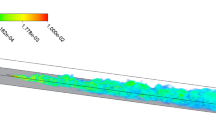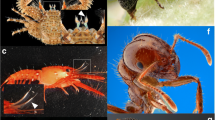Abstract
Many animals use chemical signals to acquire information about their habitats. The structure of this information is dependent upon specific features within a habitat, and the information in signals can be habitat-specific. We quantified the spatial and temporal information in an aquatic odor plume in three different artificial stream habitats with different substrate types by measuring turbulent odor plumes with an electrochemical detection system. Streams had one of three substrate types that correlated with typical aquatic habitats: sand (≈4.2 × 10−2 cm diameter), gravel (≈2.5 cm), and cobble (≈4.5 cm). As predicted from the hydrodynamics, the spatial and temporal structures of the signals were different on different substrates. Spectral analysis showed that the sand and cobble substrates had signals that were dominated by lower frequency fluctuations, whereas gravel had the highest and broadest range of signal fluctuations. Cross- and autocorrelations showed that signals on the gravel substrate had the largest spatial and shortest temporal components. Our results imply that the information obtained from chemical signals may be limited in some habitats. These constraints on information may affect how organisms perform chemically mediated behaviors.
Similar content being viewed by others
REFERENCES
Aylor, D. E. 1976. Estimating peak concentrations of pheromones in the forest, pp. 177-188, in J. E. Anderson and M. K. Kaya (eds.). Perspectives in Forest Entomology. Academic Press, San Diego, California.
Aylor, D. E., Parlange, Y.-J., and Granett, J. 1976. Turbulent dispersion of disparlure in the forest and male gypsy moth response. Environ. Entomol. 10:211–218.
Bell, W. J., and Tobin, T. R. 1982. Chemo-orientation. Biol. Rev. 57:219–260.
Borroni, P. F., and Atema, J. 1988. Adaptation in chemoreceptor cells I. Self-adapting backgrounds determine threshold and cause parallel shift of dose-response function. J. Comp. Physiol. A 164:67–74.
Borroni, P. F., and Atema, J. 1989. Adaptation in chemoreceptor cells II. The effects of crossadapting backgrounds depend on spectral tuning. J. Comp. Physiol. A 165:669–677.
Bossert, W. H., and Wilson, E. O. 1963. The analysis of olfactory communication among animals. J. Theor. Biol. 5:443–469.
Cheer, A. Y. L., and Koehl, M. A. R. 1987. Paddles and rakes: fluid flow through bristled appendages of small organisms. J. Theor. Biol. 129:17–39.
Devine, D. V., and Atema, J. 1982. Function of chemoreceptor organs in spatial orientation of the lobster Homarus americannus: Differences and overlap. Biol. Bull. 163:144–153.
Gerhardt, G. A., Oke, A. F., Nagy, G., Moghaddam, B., Adams, R. N. 1984. Nafion-coated electrodes with high selectivity for CNS electrochemistry. Brain Res. 290:390–395.
Gifford, F. A. 1968. An outline of theories of diffusion of lower layers of the plume dispersion model. Int. J. Air. Pollut. 3:253–260.
Gleeson, R. A., Carr, W. E. S., and Trapido-Rosenthal, H. G. 1993. Morphological characteristics facilitating stimulus access and removal in the olfactory organ of the spiny lobster Panulirus argus: Insight from design. Chem. Senses 18:67–75.
Gomez, G., Voigt, R., and Atema, J. 1994. Frequency filter properties of lobster chemoreceptor cells determined with high resolution stimulus measurement. J. Comp. Physiol. A 174:803–811.
Hart, D. D., Clark, B. D., and Jasentuliyana, A. 1996. Fine-scale field measurement of benthic flow environments inhabited by stream invertebrates. Limnol. Oceangr. 41:297–308.
Hodgson, E. S., and Matthewson, R. F. 1971. Chemosensory orientation in sharks. Ann. N.Y. Acad. Sci. 188:175–182.
Johnsen, P. B., and Teeter, J. H. 1980. Spatial gradient detection of chemical cues by catfish. J. Comp. Physiol. 140:95–99.
Kennedy, J. S. 1982. Mechanism of moth attraction: a modified view based on wind tunnel experiments with flying male Adoxophyes. Colloq. INRA 7:189–192.
Kundu, P. K. 1990. Fluid Mechanics. Academic Press, New York.
Mafra-Neto, A., and CardÉ, R. T. 1994. Fine-scale structure of pheromone plumes modulates upwind orientation of flying moths. Nature 369:142–144.
Mafra-Neto, A., and CardÉ, R. T. 1995. Influence of plume structure and pheromone concentration on the upwind flight of Cadra cautella males. Physiol. Entomol. 20:117–133.
Mann, K. H., and Lazier, J. R. N. 1996. Dynamics of Marine Ecosystems: Biological-Physical Interactions in the Oceans. Blackwell Science, Cambridge, Massachusetts.
Moore, P. A. 1994. A model of adaptation and disadaptation in olfactory receptor neurons: Implications for the coding of temporal and intensity patterns in odor signals. Chem. Senses 19:71–86.
Moore, P. A., and Atema, J. 1991. Spatial information in the three-dimensional fine structure of an aquatic odor plume. Biol. Bull. 181:408–418.
Moore, P. A., and Grills, J. 1999. Chemical orientation to food by the crayfish, Orconectes rusticus: Influence by hydrodynamics. Anim. Behav. 58:953–963.
Moore, P. A., Gerhardt, G. A., and Atema, J. 1989. High resolution spatio-temporal analysis of aquatic chemical signals using microelectrochemical electrodes. Chem. Senses 14:829–840.
Moore, P. A., Atema, J., and Gerhardt, G. A. 1991a. Fluid dynamics and microscale chemical movement in the chemosensory appendages of the lobster, Homarus americanus. Chem. Senses 16:663–674.
Moore, P. A., Scholz, N., and Atema, J. 1991b. Chemo-orientation of lobsters, Homarus americanus in turbulent odor plumes. J. Chem. Ecol. 17:1293–1307.
Moore, P. A., Weissburg, M. J., Parrish, J. M., Zimmer-Faust, R. K., and Gerhardt, G. A. 1994. Spatial distribution of odors in simulated benthic boundary layer flows. J. Chem. Ecol. 20:255–279.
Murlis, J. 1986. The structure of odour plumes, pp. 27-38, in T. L. Payne, M. C. Birch, and C. E. J. Kennedy (eds.). Mechanisms in Insect Olfaction. Claredon Press, Oxford.
Murlis, J., and Jones, C. D. 1981. Fine-scale structure of odour plumes in relation to insect orientation to distant pheromone and other attractant sources. Physiol. Entomol. 6:71–86.
Nowell, A. R. M., and Jumars, P. A. 1984. Flow environments of aquatic benthos. Annu. Rev. Ecol. Syst. 15:303–328.
Nowell, A. R. M., and Jumars, P. A. 1987. Flumes: Theoretical and experimental considerations for simulation of benthic environments. Oceanogr. Mar. Biol. Annu. Rev. 25:91–112.
Pasquill, F. 1961. The estimation of the disperson of wind-borne material. Meteorol Mag. 90:33–49.
Payne, T. L., Birch, M. C., and Kennedy, C. E. J. (eds.). 1986. Mechanisms in Insect Olfaction. Claredon Press, Oxford.
Peckarsky, B. L. 1980. Predator-prey interactions between stoneflies and mayflies: Behavioral observations. Ecology 61:932–943.
Petranka, J. W., Kats, L. B., and Sih, A. 1987. Predator-prey interaction among fish and larval amphibians: Use of chemical cues to detect prey. Anim. Behav. 35:420–425.
Rubenstein, D. I., and Koehl, M. A. R. 1977. The mechanisms of filter feeding: Some theoretical considerations. Am. Nat. 111:981–994.
Sanford, L. P. 1997. Turbulent mixing in experimental ecosystem studies. Mar. Ecol. Prog. Ser. 161:265–293.
Schlichting, H. 1979. Boundary-Layer Theory, 7th ed. McGraw-Hill, New York.
Schneider, R. W. S., Price, B. A., and Moore, P. A. 1998a. Antennae morphology as a physical filter of olfaction: Temporal tuning of the antennae of the honeybee Apis mellifera. J. Insect Physiol. 44:677–684.
Schneider, R. W. S., Lanzen, J., and Moore, P. A. 1998b. Boundary layer effect on chemical signal movement near the antennae of the Sphinx moth Manduca sexta: Temporal filters for olfaction. J. Comp. Physiol. A 182:287–305.
Suckling, D. M., and Karg, G. 1997. The role of foliage on mating disruption in apple orchards. Technology transfer in mating disruption. IOBC WPRS Bull. 20:169–174.
Suckling, D. M., Karg, G., and Bradley, S. J. 1996. Apple foliage enhances mating disruption of lightbrown apple moth. J. Chem. Ecol. 22:325–341.
Sutton, O. G. 1953. Micrometeorology. McGraw-Hill, New York.
Tennekes, H., and Lumley, J. L. 1972. A First Course in Turbulence. MIT Press, Cambridge, Massachusetts.
Vickers, N. J., and Baker, T. C. 1992. Male Heliothis virescens maintain upwind flight in response to experimentally pulsed filaments of their sex pheromone (Lepidoptera: Noctuidae). J. Insect Behav. 5:669–687.
Vickers, N. J., and Baker, T. C. 1994. Reiterative responses to single strands of odor promote sustained upwind flight and odor source location by moths. Proc. Natl. Acad. Sci. U.S.A. 91:5756–5760.
Weissburg, M. J., and Zimmer-Faust, R. K. 1993. Life and death in moving fluids: Hydrodynamic effects on chemosensory-mediated predation. Ecology 74:1428–1443.
Westerberg, H. 1991. Properties of aquatic odour trails, pp. 45-65, in K. Dø ving (ed.). Proceedings of the Tenth International Symposium on Olfaction and Taste. Graphic Communication System, Oslo.
Zimmer-Faust, R. K., Sanfill, J. M., and Collard III, S. B. 1988. A fast multichannel fluorometer for investigating aquatic chemoreception and odor trails. Limnol. Oceanogr. 33:1586–1595.
Author information
Authors and Affiliations
Rights and permissions
About this article
Cite this article
Moore, P.A., Grills, J.L. & Schneider, R.W.S. Habitat-specific Signal Structure for Olfaction: An Example from Artificial Streams. J Chem Ecol 26, 565–584 (2000). https://doi.org/10.1023/A:1005482027152
Issue Date:
DOI: https://doi.org/10.1023/A:1005482027152




